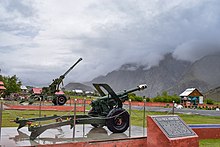| Revision as of 15:47, 6 November 2019 editPoornapragna G A (talk | contribs)18 editsm Added important information for visitors.Tag: Visual edit← Previous edit | Revision as of 19:21, 27 December 2019 edit undoSpacemarine10 (talk | contribs)Extended confirmed users857 edits Removed some POV material and proofread everythingTag: Visual edit: SwitchedNext edit → | ||
| Line 1: | Line 1: | ||
| ] | ] | ||
| ]'''Kargil War Memorial''' |
]The '''Kargil War Memorial''' is a war memorial built by the ] in the town of ], commemorating the 1999 ] between ] and ].<ref>{{cite web|url=http://www.rediff.com/news/slide-show/slide-show-1-drass-memorial-invoking-memories-of-kargil-war/20110727.htm#2|title=Drass memorial: Invoking memories of Kargil war|date=27 July 2011|work=Rediff}}</ref> The memorial is located on the ]-] ],<ref name="autogenerated1">{{cite web|url=http://jktourism.org/index.php/dras-war-memorial-vijaypath|title=Dras War Memorial - Vijaypath|work=jktourism.org}}</ref> about 5 km from the city centre across the ]. | ||
| ==History== | ==History== | ||
| In the winter of 1998-1999, Pakistani Army |
In the winter of 1998-1999, the Pakistani Army crossed the ] (LoC) and occupied numerous heights dominating the National Highway and roads connecting Leh (Ladakh) and Kargil to Srinagar. The Indian Army launched ] ("Victory") in May 1999 to retake the territory, leading to fierce battles in the harsh mountain environment. Each year, 26 July is observed as ] (Kargil Victory Day), during which the ] pays tribute to the soldiers at Amar Jawan Jyothi at the ], ].<ref name="autogenerated1" /> | ||
| A |
A makeshift memorial is said to have been constructed at the site to honor Indian troops in 2000. The memorial in its present form was constructed by the Indian Army in November 2014. | ||
| ==Design== | |||
| Captain Manoj Pandey gallery is an important part of the memorial dedicated to the supreme sacrifice done by the young officer who was awarded Param Vir Chakra. | |||
| The central feature of the memorial is a pink sandstone wall bearing a brass plate engraved with names of the soldiers who died during Operation Vijay. Visible from the site are the Tololing Heights, Tiger Hill, and Point 4875 (Batra Top), where fighting took place during the conflict.<ref>{{cite web|url=http://jktourism.org/index.php/kargil-war-memorial|title=Kargil War Memorial|work=jktourism.org}}</ref> | |||
| The memorial features the Captain ] gallery, which commemorates a young officer who was posthumously awarded the Param Vir Chakra, India's highest military award, for leadership during the war. | |||
| ⚫ | Over the years, |
||
| ⚫ | Over the years, several infrastructural improvements have been made to the site. On 26 July 2012, the Flag Foundation of India presented too the memorial a giant national flag measuring {{convert|37+1/2|by|25|ft|m|order=flip}} and weighing 15 kg, on a {{convert|100|ft|m|order=flip|adj=on}} flag pole. The Dras War Memorial is now an important landmark and a major tourist attraction in Western Ladakh—in the year 2016, it received about 1,25,000 visitors. | ||
| ⚫ | ] | ||
| ⚫ | ] | ||
| ==References== | ==References== | ||
Revision as of 19:21, 27 December 2019


The Kargil War Memorial is a war memorial built by the Indian Army in the town of Dras, commemorating the 1999 Kargil War between India and Pakistan. The memorial is located on the Srinagar-Leh National Highway 1D, about 5 km from the city centre across the Tiger Hill.
History
In the winter of 1998-1999, the Pakistani Army crossed the Line of Control (LoC) and occupied numerous heights dominating the National Highway and roads connecting Leh (Ladakh) and Kargil to Srinagar. The Indian Army launched Operation Vijay ("Victory") in May 1999 to retake the territory, leading to fierce battles in the harsh mountain environment. Each year, 26 July is observed as Kargil Vijay Diwas (Kargil Victory Day), during which the Prime Minister of India pays tribute to the soldiers at Amar Jawan Jyothi at the India Gate, New Delhi.
A makeshift memorial is said to have been constructed at the site to honor Indian troops in 2000. The memorial in its present form was constructed by the Indian Army in November 2014.
Design
The central feature of the memorial is a pink sandstone wall bearing a brass plate engraved with names of the soldiers who died during Operation Vijay. Visible from the site are the Tololing Heights, Tiger Hill, and Point 4875 (Batra Top), where fighting took place during the conflict.
The memorial features the Captain Manoj Pandey gallery, which commemorates a young officer who was posthumously awarded the Param Vir Chakra, India's highest military award, for leadership during the war.
Over the years, several infrastructural improvements have been made to the site. On 26 July 2012, the Flag Foundation of India presented too the memorial a giant national flag measuring 11.4 by 7.6 metres (37+1⁄2 by 25 ft) and weighing 15 kg, on a 30-metre (100 ft) flag pole. The Dras War Memorial is now an important landmark and a major tourist attraction in Western Ladakh—in the year 2016, it received about 1,25,000 visitors.

References
- "Drass memorial: Invoking memories of Kargil war". Rediff. 27 July 2011.
- ^ "Dras War Memorial - Vijaypath". jktourism.org.
- "Kargil War Memorial". jktourism.org.
34°26′00″N 75°48′21″E / 34.4332369°N 75.8058092°E / 34.4332369; 75.8058092
External links
 Media related to Kargil War Memorial at Wikimedia Commons
Media related to Kargil War Memorial at Wikimedia Commons- Kargil War Memorial - Honouring our War Heroes